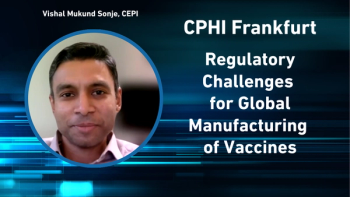
- Pharmaceutical Technology-05-01-2009
- Volume 2009 Supplement
- Issue 2
Trend Analysis for Sterile Manufacturing
A Pharmaceutical Technology survey examines capacity expansions, outsourcing practices, innovation levels, and the role of quality by design in sterile manufacturing and aseptic processing.
Sterile manufacturing and aseptic processing are important in pharmaceutical manufacturing. To gain a perspective, Pharmaceutical Technology conducted a survey to gauge investments in manufacturing capacity, outsourcing practices, the level of innovation, and the influence of quality by design (QbD). The survey found a fairly strong level of investment in sterile manufacturing and aseptic processing in 2008 and slightly lower levels planned for 2009. Respondents were almost evenly divided in their decision whether to keep manufacturing in house or to outsource and were generally satisfied with the level of innovation in equipment and machinery. And QbD is playing a significant role in companies' sterile-manufacturing practices.
JUNIOR GONZALEZ/GETTY IMAGES
Capacity expansions
More than half, or 58.3%, of respondents said that their companies added capacity for sterile manufacturing or aseptic processing in 2008 (see Figure 1). Almost 40% of respondents said that their companies were planning to add capacity in 2009 or 2010 (see Figure 2).
Figure 1
For those companies that added capacity in 2008, 46% added capacity for finished-product manufacturing. Fifteen percent increased capacity for drug-substance manufacturing, and 39% added capacity in both areas. A similar distribution holds for companies planning to add capacity in 2009 or 2010. Of those companies, 44% plan to add capacity for both drug-substance and finished-product manufacturing. Thirty-nine percent will add capacity for finished-product manufacturing only, and 17% plan to add capacity for drug-substance manufacturing only.
Figure 2
The overwhelming majority of respondents did not have capabilities for sterile manufacturing or aseptic processing for cytotoxic or high-potency products. Approximately 62% of companies responding to the survey did not perform sterile manufacturing or aseptic processing of these products, and 38% did (see Figure 3). Of the companies that did not perform cytotoxic or high-potency manufacturing, only 13% were considering adding this capability.
Figure 3
Outsourcing
Respondents were almost evenly divided regarding whether they kept sterile manufacturing or aseptic manufacturing in house or outsourced. Forty-eight percent of respondents said that their companies outsource sterile manufacturing or aseptic processing, and 52% do not outsource (see Figure 4). Of those companies that do outsource, 57% outsource both drug-substance and finished-product manufacturing (see Figure 5). Thirty-three percent outsource manufacturing for finished products only, and 9% outsource only drug-substance manufacturing.
Figure 4
The number one reason for outsourcing is companies believe that it is more cost-effective than producing a product internally. Almost half of all respondents, or 47%, said that outsourcing was more cost-effective than captive production. The other reasons for outsourcing are limited or no internal manufacturing capacity (39% responded thus) and an increase in projects requiring sterile manufacturing (35% responded thus).
Figure 5
Quality by design
The survey examined the importance and application of QbD to sterile manufacturing or aseptic processing. Seventy-one percent of respondents said that their companies are incorporating QbD in their sterile-manufacturing activities, and 29% are not (see Figure 6). A smaller percentage of respondents are implementing process analytical technology (PAT). Forty-five percent of respondents are incorporating PAT, and 55% are not.
Figure 6
For those companies not integrating QbD into their sterile-manufacturing activities, 43% of respondents said that they do not see process advantages to be gained with QbD. Forty percent said their companies are not incorporating QbD because they lack an understanding of QbD, and 32% said they were not implementing QbD because they lack guidance or direction from regulatory authorities. Almost one-quarter, or 23%, said that they were not using QbD because it was too costly.
Respondents profile
The leading benefits gained by companies that have incorporated QbD or PAT into their sterile-manufacturing activities include achieving better process understanding (51% responded thus), improved manufacturing efficiency (48% responded thus), and better regulatory compliance (44% responded thus). And almost one-third of respondents, or 31%, said that their companies lowered costs through QbD.
To implement QbD, 45% of respondents said their companies had to modify or add equipment, and 55% did not (see Figure 7). Similar results were observed for those companies incorporating PAT. Forty-five percent of respondents said that they added or modified equipment when implementing PAT, and 55% did not.
Figure 7
Innovation
The survey evaluated the level of innovation in specific equipment areas relating to sterile manufacturing and aseptic processing. Respondents were generally satisfied with the level of innovation for isolators and barrier systems. Thirty-one percent of respondents characterized the level of innovation as "very good," and 46% said it was "good." Twenty-percent said the level was "satisfactory" (see Figure 8).
Figure 8
Respondents were also generally content about the level of innovation for steam-in-place (SIP) and clean-in-place (CIP) systems for sterile manufacturing. Sixty-nine of respondents characterized innovation in SIP and CIP systems as either "very good" or "good" (see Figure 8).
Respondents were less satisfied with the level of innovation in gowning, automation, and robotics although these areas still received positive ratings. Twenty percent said that the level of innovation in gowning was "very good," 39% said it was "good," and 36% said it was "satisfactory" (see Figure 8). For automation, only 20% of respondents rated innovation as "very good," 43% classified it as "good," and 31% said it was "satisfactory" (see Figure 8). Robotics received slightly lower marks. Fifteen percent classified innovation as "very good," 34% rated it as "good," and 36% ranked it as "satisfactory" (see Figure 8).
Spending
The survey measured spending on equipment and machinery for sterile manufacturing or aseptic processing. Thirty-seven percent of respondents increased spending on equipment and machinery for sterile manufacturing or aseptic processing in 2008 compared with 2007. Twenty-three percent said their spending stayed the same, and 8% decreased spending. For 2009, respondents plan to spend less than they did in 2008. Twenty-four percent plan to increase spending in 2009, and 23% plan to keep it at the same level. Sixteen percent said they plan to decrease spending this year. Companies spent an average of 3.9% of their sales on equipment and machinery for sterile manufacturing or aspetic processing in 2008 and plan to spend on average of 3.4% of their sales this year.
Articles in this issue
over 16 years ago
Applying Quality by Design to Sterile Manufacturing Processesover 16 years ago
Disposable Components in Aseptic Processingover 16 years ago
The Impact of Automation on Aseptic ProcessingNewsletter
Get the essential updates shaping the future of pharma manufacturing and compliance—subscribe today to Pharmaceutical Technology and never miss a breakthrough.





